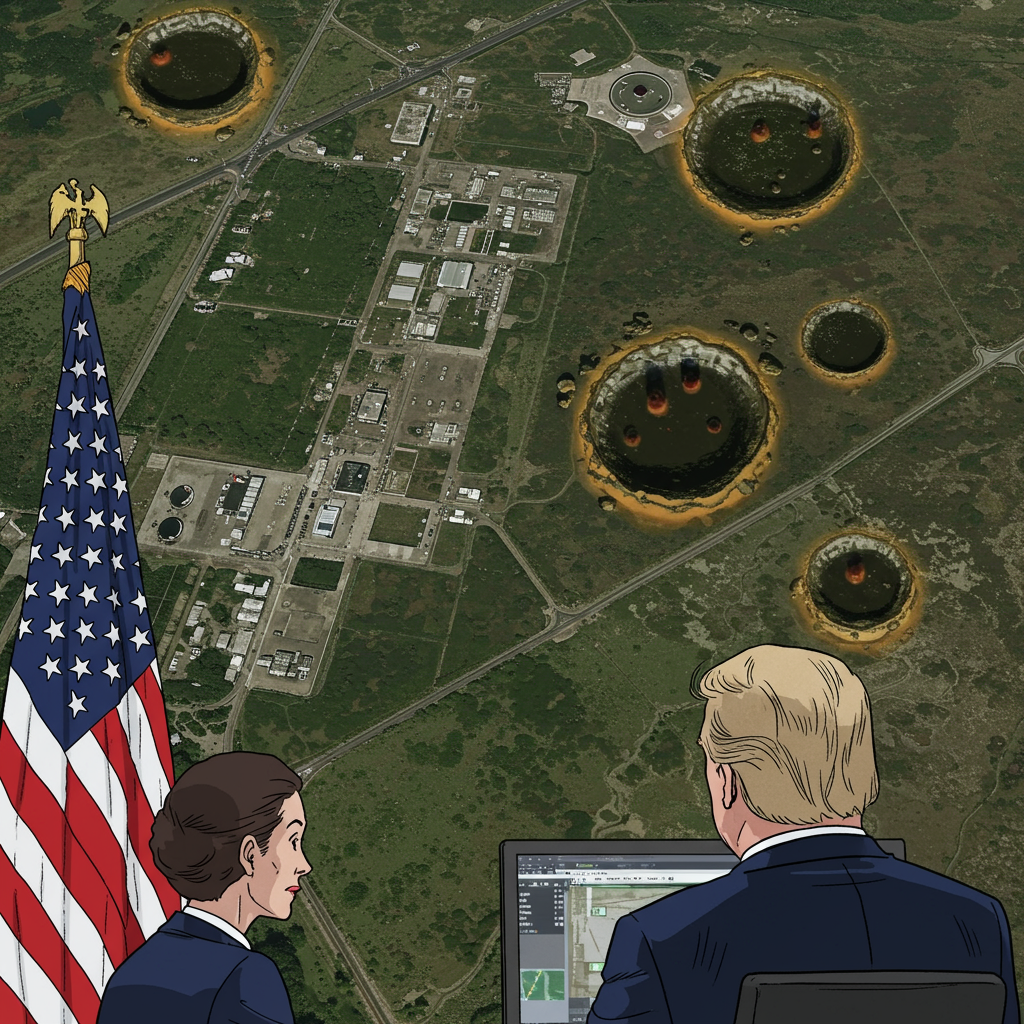Following recent US military action, satellite imagery has emerged showing impact craters at Iran’s key nuclear sites, raising critical questions about the extent of the damage inflicted. The strikes, ordered by US President Donald Trump, targeted three crucial facilities: Fordow, Natanz, and Isfahan.
Dubbed “Operation Midnight Hammer,” the mission involved an extraordinary display of force, utilizing a large package of US military aircraft, including B-2 stealth bombers on an 18-hour flight, submarines, cruise missiles, and massive 30,000-pound bunker-busting bombs. While President Trump claimed Iran’s nuclear facilities had been “obliterated,” Iranian officials initially downplayed the impact, a response consistent with past incidents involving strikes on their nuclear infrastructure.
With the first satellite images becoming available, analysis by CNN and others, supported by expert commentary and details from the US military, provides a clearer, though still incomplete, picture of the damage.
Fordow: Target Deep Within the Mountain
Fordow stands out as one of Iran’s most significant nuclear enrichment sites, strategically built deep inside a mountain near Qom for protection against aerial attacks. Its main halls are reportedly buried between 80 and 90 meters (around 262 to 295 feet) underground. Analysts have long believed that only the US possesses the capability to penetrate such depths with specialized weapons like the GBU-57, also known as the Massive Ordnance Penetrator (MOP).
According to US officials, six B-2 bombers were used to drop a total of 12 or 14 of these powerful “bunker-busting” bombs on the Fordow site. Satellite imagery analyzed by Maxar Technologies and CNN showed at least six large impact craters on the ridge directly above the underground complex. These craters are consistent with the entry points of bunker-busting munitions designed to penetrate before detonating deep below the surface.
Munitions specialists noted the irregular shapes and proximity of some entry holes, suggesting multiple bombs struck the same precise locations. This technique aims to “smash” and blast a path through significant layers of earth and rock to reach the protected areas underground. Satellite photos also revealed large areas of grey ash covering the mountainside, indicating the immense scale of the strikes.
Rafael Grossi, head of the IAEA, confirmed a “direct kinetic impact” on Fordow but stressed that assessing internal damage to the deeply buried facility would take time. Despite initial Iranian claims of only “superficial” damage and assertions that materials and personnel had been moved prior to the attack, experts like David Albright of the Institute for Science and International Security suggested these claims should be dismissed based on the satellite evidence, which pointed to potentially “considerable” or even “total destruction” of underground areas. Imagery collected before the strikes even suggested Iran had attempted to reinforce tunnel entrances, possibly in anticipation of an attack.
The strike on Fordow marked the first operational use of the GBU-57 MOP. While US assessments suggested “extremely severe damage,” the full impact on the underground enrichment centrifuges remains unclear.
Natanz: A Mixed Picture of Damage
Natanz hosts Iran’s largest nuclear enrichment center and has been a frequent target. It includes both above-ground buildings and deep underground structures housing centrifuges. Previous Israeli strikes reportedly damaged the above-ground facilities, including electrical infrastructure, and potentially impacted underground centrifuges by cutting off power.
The US strikes on Saturday night also targeted Natanz. A B-2 bomber reportedly dropped two bunker-busting bombs here, while US Navy submarines launched dozens of Tomahawk cruise missiles at Natanz and Isfahan. Satellite imagery analysis revealed two new craters at Natanz, located directly above the underground sections of the complex, likely caused by the MOPs.
While these new craters provide evidence of penetration attempts, the precise extent of the resulting damage to the underground facilities and their critical centrifuges is currently unknown. Earlier assessments following the Israeli strikes had suggested significant damage to the above-ground plant and underground centrifuges, even without direct hits on the buried areas.
Isfahan: A Focus on Research and Storage
Located in central Iran, Isfahan is home to a major atomic research complex established with Chinese support. Believed by some to be a central hub of Iran’s nuclear program, the site employs thousands of scientists.
During the US operation, submarines reportedly fired over two dozen Tomahawk cruise missiles at Isfahan. Satellite imagery analysis by CNN showed extensive damage, with at least 18 structures appearing destroyed or partially destroyed, and the site visibly blackened by debris. The IAEA later confirmed six buildings were damaged at Isfahan, including a workshop.
There were also reports, although not independently verified by CNN, that the US targeted tunnel complexes near Isfahan potentially used to store enriched uranium. If confirmed, this would indicate a US objective to eliminate Iran’s stockpiles of uranium enriched to levels such as 20% and 60%, significantly below weapons-grade (90%) but still a crucial step toward it.
Conflicting Claims and Potential Next Steps
Immediately following the strikes, Iranian officials offered conflicting accounts, from downplaying the damage to strong condemnations. Foreign Minister Abbas Araghchi called the US action “outrageous” and a “very big red line,” warning of “everlasting consequences.” However, internal claims suggested facilities were evacuated and materials moved, potentially explaining reports of no significant off-site radiation increase observed by Iran and the IAEA.
The US assessment claimed “extremely severe damage and destruction” across all three sites and that the operation achieved its desired effect. President Trump stated that future attacks without a diplomatic solution would be “far greater,” noting “many targets left.” Defence Secretary Pete Hegseth asserted the US had “devastated the Iranian nuclear program,” while emphasizing the operation did not target Iranian personnel or civilians and was not aimed at regime change.
In response to the US strikes, Iran quickly retaliated by launching missiles at targets in Israel, causing dozens of injuries. This immediate counter-strike underscored the volatile situation.
Analysts are considering various potential responses from Iran, ranging from further targeting US interests and personnel in the region through proxy forces, attempting to disrupt global oil trade via the Strait of Hormuz, or accelerating its efforts to build a nuclear weapon. Withdrawing from the Nuclear Non-Proliferation Treaty (NPT) has also been raised as a possibility. Less likely options include a return to diplomacy, which seems improbable given the current level of escalation.
The full, long-term impact of these US strikes on Iran’s nuclear program remains uncertain. While tactical success is claimed, verifying the complete destruction or incapacitation of underground facilities requires further intelligence and potentially on-the-ground assessment. The strikes represent a significant escalation, sending powerful signals about US capabilities but also raising risks of wider regional conflict and potential unforeseen consequences.


